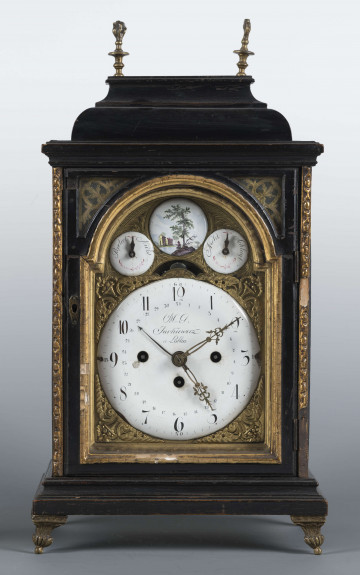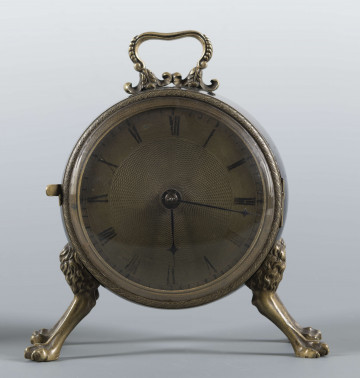
Fireplace clock
1801 — 1810
National Museum in Lublin
Part of the collection: Clocks
Cabinet floor clocks appeared in England in the middle of the 17th century and quickly gained popularity. In the following century the fashion for this type of timepieces had already spread throughout Europe. The clock is driven by two weights, which initiate the mechanism thanks to the force of gravity. The mechanism is placed on top of a tall cabinet, which extends its working time so that it only needs to be wound once a week. A significant number of English clocks were made for export. They also reached Poland by sea through the port of Gdańsk. In order to reduce the costs, only the mechanisms were imported and assembled in domestic cabinets made mainly in Gdańsk and Elbląg. The form of the cabinet with characteristic marquetry indicates that it was made in an Elbląg workshop, but the mechanism is original. A small window in the dial shows the date, and above it there is the seconds hand. This was a modern solution at the time, as the seconds hand did not appear in clocks until around 1700. At the top, there was a switch so that the clock would not wake the household members at night. Inside there is an additional device called a repeater: by pulling a string you will hear the last hour beating again. The signature informs that the clock was made by William Smith in London. Smith belonged to a family where watchmaking had been practised since the 17th century. He himself was active in London between 1750 and 1780, and had a workshop on Cheapside, which was then a major centre of trade and is now one of the most important streets in the City of London. This speaks volumes for the fact that Smith's workshop flourished.
Barbara Czajkowska
Author / creator
Dimensions
cały obiekt: height: 56 cm, width: 240 cm
Object type
goldsmith's art
Technique
gilding
Material
brass, steel, pine wood, ash veneer
Creation / finding place
Owner
The National Museum in Lublin
Identification number
Location / status

1801 — 1810
National Museum in Lublin

1800 — 1810
National Museum in Lublin

1790 — 1800
National Museum in Lublin
DISCOVER this TOPIC
Castle Museum in Łańcut
DISCOVER this PATH
Educational path